Titanoboa
Titanoboa cerrejonensis
The Titanoboa was a massive, 42-foot-long boa constrictor that lives 58-60 million years ago.
Advertisement
Titanoboa Scientific Classification
- Kingdom
- Animalia
- Phylum
- Chordata
- Class
- Reptilia
- Order
- Squamata
- Family
- Boidae
- Genus
- Titanoboa
- Scientific Name
- Titanoboa cerrejonensis
Read our Complete Guide to Classification of Animals.
Titanoboa Conservation Status
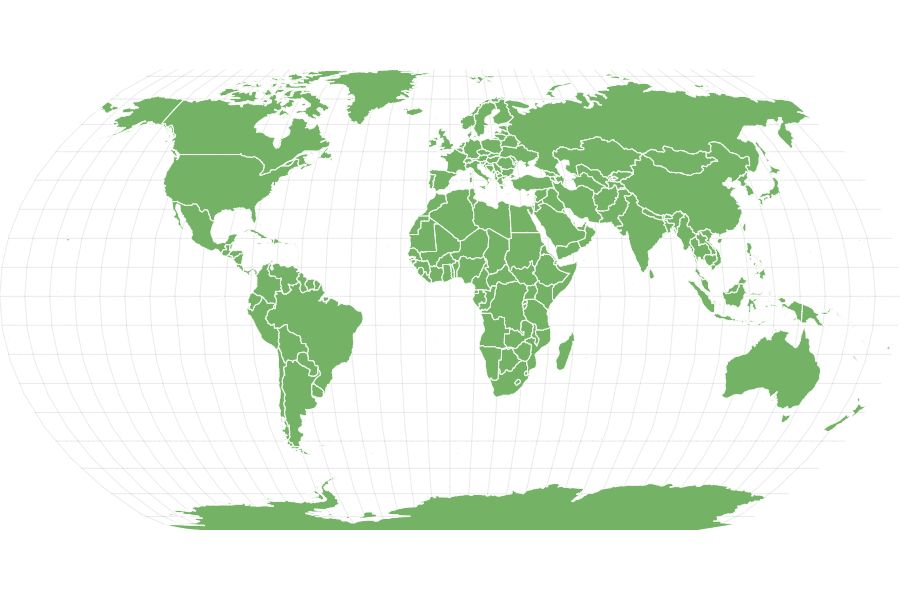
Titanoboa Facts
Titanoboa Physical Characteristics
View all of the Titanoboa images!
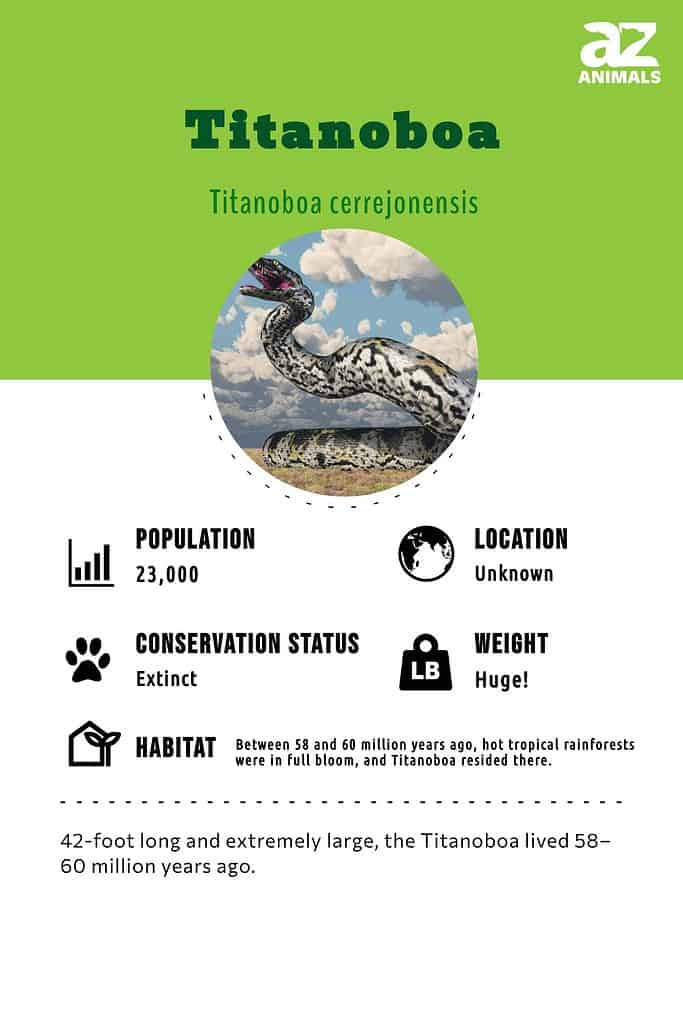
Titanoboa Description & Size
If you think the 15-foot-long anaconda is a horror show, imagine titanoboa, a 42-foot-long boa constrictor that was 3 feet wide at its widest point. There are some who even believe this snake could grow to 50 feet in length.
Not only that, it could weigh as much as 2,500 pounds which is well over a ton. Indeed, it was the largest predator on earth during the middle to the latter part of the Paleocene epoch. Titanoboa came after the meat-eating dinosaurs went extinct 65 million years ago and before the arrival of the megalodon, a monstrous, 33.5-foot-long shark whose very name means “big tooth.”
Paleontologists also believe that Titanoboa had brownish or grayish skin, which camouflaged it, at least somewhat, in the muddy rivers of the tropical rainforests where it flourished. How fast it moved on land and whether or not it could climb trees is debatable.
Though scientists have only found some sections of the snake’s backbone and pieces of its skull, it was enough to let them calculate the fantastic size of this snake and discover that it was a snake in the first place. They could even tell that it was related to modern boas and anacondas and placed it in the still extant Boidae family.
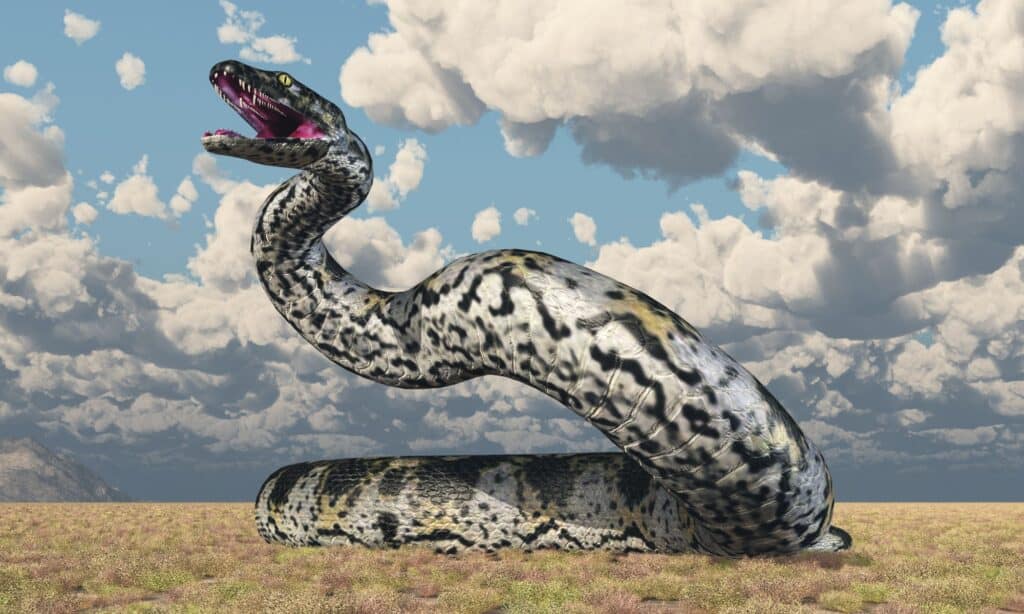
Titanoboa was a 42-foot-long boa constrictor that lived 58-60 million years ago.
©Michael Rosskothen/Shutterstock.com
Origin of Its Name

The titans, mighty ancient gods from Greek mythology, are the source of Titanoboa’s name.
©Michael Rosskothen/Shutterstock.com
Titanoboa gets its name from the Titans, great old gods from Greek mythology. Boa comes from the Latin name for a large serpent from Pliny the Elder’s Natural History. Cerrejonensis means “, “Cerrejón” because the first fossils were found in the Cerrejón coal mine in La Guajira, Colombia. There do not appear to be any subspecies of T. cerrejonensis.
Diet – What Did the Titanoboa Eat?
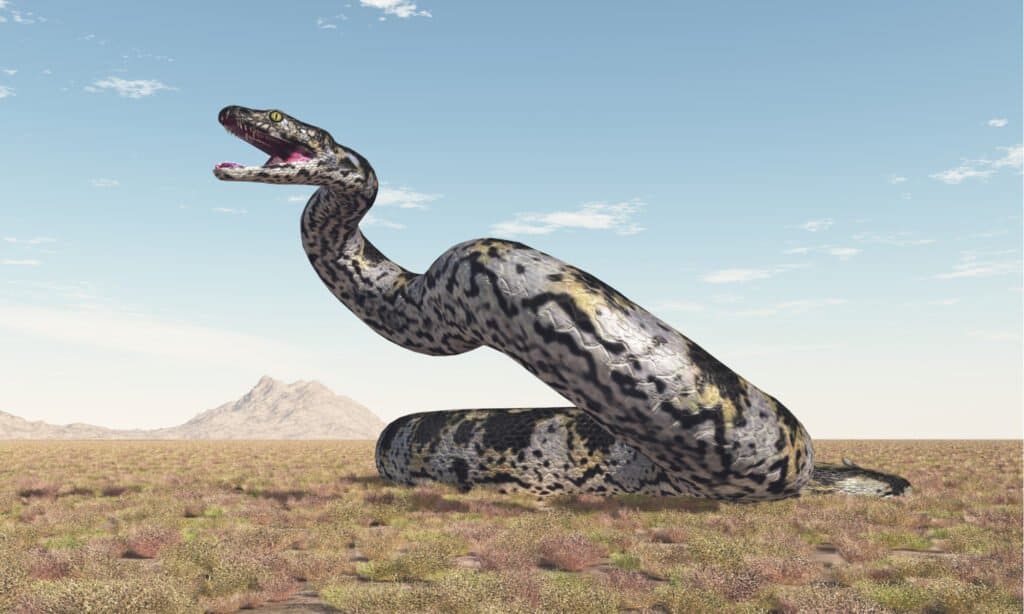
A snake the size of Titanoboa might seem like it could eat anything it wanted, but researchers think the snake largely consumed fish.
©Michael Rosskothen/Shutterstock.com
One would think that a snake the size of Titanoboa could eat anything it fancied, but scientists believe that the snake ate mostly fish. They came to this conclusion because of the snake’s palate and the number and anatomy of its teeth.
The fish were most likely types of lungfish or types of bony fish called osteoglossomorphs. Most of these fish are now extinct. When it wasn’t eating fish, Titanoboa probably ate other reptiles, crocodilians, and birds. A grown Titanoboa could quite easily vanquish a 300-pound turtle.
Habitat – When and Where It lived

Between 58 and 60 million years ago, hot tropical jungles that are now extinct were home to Titanoboa.
©Dotted Yeti/Shutterstock.com
Titanoboa lived in the hot tropical rainforests that flourished between 58 and 60 million years ago, well after all the carnivorous predatory dinosaurs such as Tyrannosaurus rex were safely dead. Because it was so large and heavy, the snake probably spent most of its life in the many rivers of its habitat.
As with a large shark or whale, the water would have kept its 2-ton body buoyant. It’s possible that the snake could hold its breath underwater for as long as an hour.
Threats And Predators
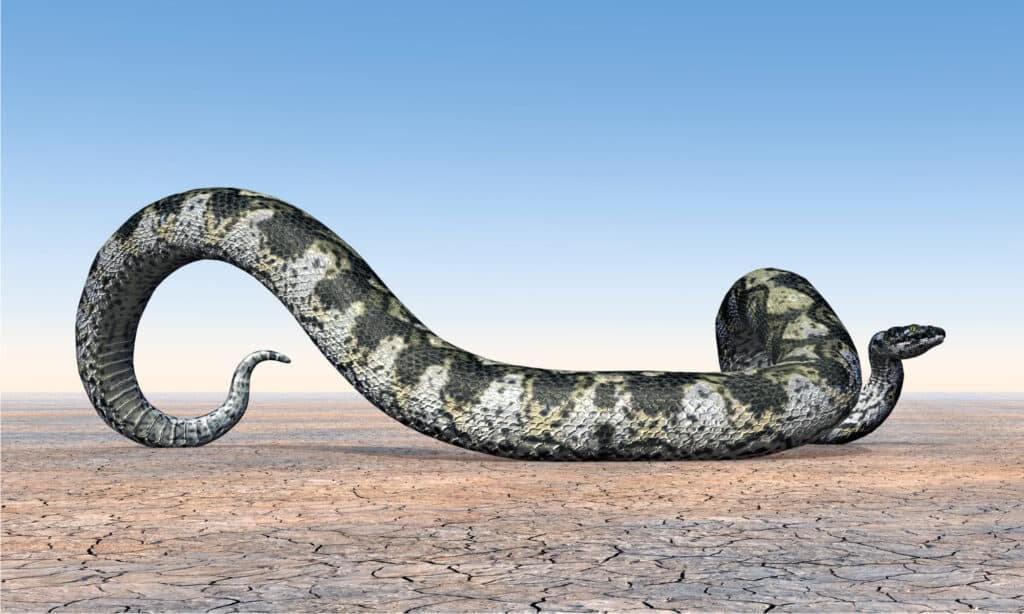
Titanoboas lived in rainforests, which eventually gave way to grasslands. This is one reason that is thought to have led to the creature’s extinction.
©Michael Rosskothen/Shutterstock.com
Titanoboa was the apex predator not just of South America but basically of the entire planet. Paleontologists have not yet found any animal that would have dared to prey on a grown Titanoboa. Indeed, some scientists believe the snake gladly swallowed whole crocodilians along with fish.
However, it is possible that baby titanoboas and Titanoboa eggs were preyed upon by the same crocodilians the adults ate. The one threat to the species as a whole was climate change. In this case, the climate started to cool which bode ill for Titanoboa.
Discoveries and Fossils – Where It was Found
The first Titanoboa fossils were discovered quite recently. The fossils of 30 of the snakes were discovered in 2009 in the Cerrejón coal mines by paleontologist Jonathan Bloch and his colleagues. The team discovered the fossils in rocks that dated back 58 million years.
They not only discovered the bones of this snake but evidence that it lived in a primeval rainforest. Now, fossilized vertebrae of the snake can be found in the Geological Museum José Royo y Gómez in Bogota, Colombia.
Extinction – When Did It Die Out?
Titanoboa died out around 58 to 60 million years ago, so its dominance was fairly brief in geological terms. Scientists aren’t quite sure, but they believe that climate change had something to do with it. The climate started to cool, and the enormous snake and other large reptiles couldn’t maintain their metabolism.
Also, the rainforests where Titanoboa reigned gave way to grassland over time. All of this paved the way for the emergence and eventual dominance of smaller reptiles.
Similar Animals to the Titanoboa
Some of the animals similar to the Titanoboa are:
- Gigantophis garstini. This snake lived during the Eocene epoch around 40 million years ago in what is now Algeria and Egypt. It was only 30.5 to 35.1 feet long and is described from only a few bits of vertebrae.
- Eoconstrictor. These snakes also lived during the Eocene, but in Germany. The type species is E. fischeri. Eoconstrictor snakes were believed to have an infrared vision.
- Boavus. This is another extinct genus of boas. They also lived in the Eocene and were found in the western United States.
- Palaeophis. These Eocene epoch snakes could grow between 29.5 to 40.4 feet, which makes them rivals of the earlier Titanoboa in terms of length. They were aquatic snakes found in North America, Europe, and northern Africa.
Titanoboa FAQs (Frequently Asked Questions)
When was the titanoboa alive?
The titanoboa was alive during an epoch known as the Paleocene. It ruled the South American rainforests during the middle and late period of this epoch, which was 60 to 58 million years ago.
How big was the titanoboa?
The titanoboa was an astounding 42 to 50 feet long and weighed as much as 2500 pounds. It was by far the largest snake that ever lived.
Why did this snake grow as large as it did?
Scientists believe that titanoboa was allowed to reach such a huge size because the place where it lived was much warmer than it is now. The body temperatures of reptiles like titanoboa depend on the temperature of their environment, and their bodies can only get so big before their metabolism slows down to the point where they basically can’t function. A snake that lives in a warm climate can grow large because the higher temperature supports its greater mass. This is a reason why the largest snakes in the world live around the Equator.
How did titanoboa reproduce?
If the titanoboa was like other members of the Boidae family, it had a mating season. This was when the snakes, which were ordinarily solitary, congregated. The males probably fought over mating privileges, and the victor mated with an interested female. After this, it is believed the female would kill her mate and eat him. Seven months later, she would give live birth.
Who would win a fight between the Titanoboa and the Nile crocodile?
A Titanoboa would beat a Nile crocodile in a fight. Despite being born hunters with deadly accuracy and power, Nile crocodiles cannot defeat a Titanoboa with these qualities alone. The Titanoboa weighed as much as five Nile crocodiles, and this weight, coupled with their length, would have made it easy for the Titanoboa to wrap around the Nile crocodile and suffocate it to death.
Would the Titanoboa beat the largest crocodile to ever exist in a fight?
Although it would be a difficult battle, the Titanoboa would eventually emerge as the victor.
Thank you for reading! Have some feedback for us? Contact the AZ Animals editorial team.
Sources
- Wikipedia, Available here: https://en.wikipedia.org/wiki/Titanoboa
- Britannica, Available here: https://www.britannica.com/animal/Titanoboa
- All That's Interesting, Available here: https://allthatsinteresting.com/titanoboa-snake
- Florida Museum, Available here: https://www.floridamuseum.ufl.edu/100years/titanoboa/
- World Atlas, Available here: https://www.worldatlas.com/articles/titanoboa-animals-of-the-world.html
- Kidadl, Available here: https://kidadl.com/animal-facts/titanoboa-facts
- Smithsonian Magazine, Available here: https://www.smithsonianmag.com/science-nature/discovering-the-titanoboa-128065608/
















